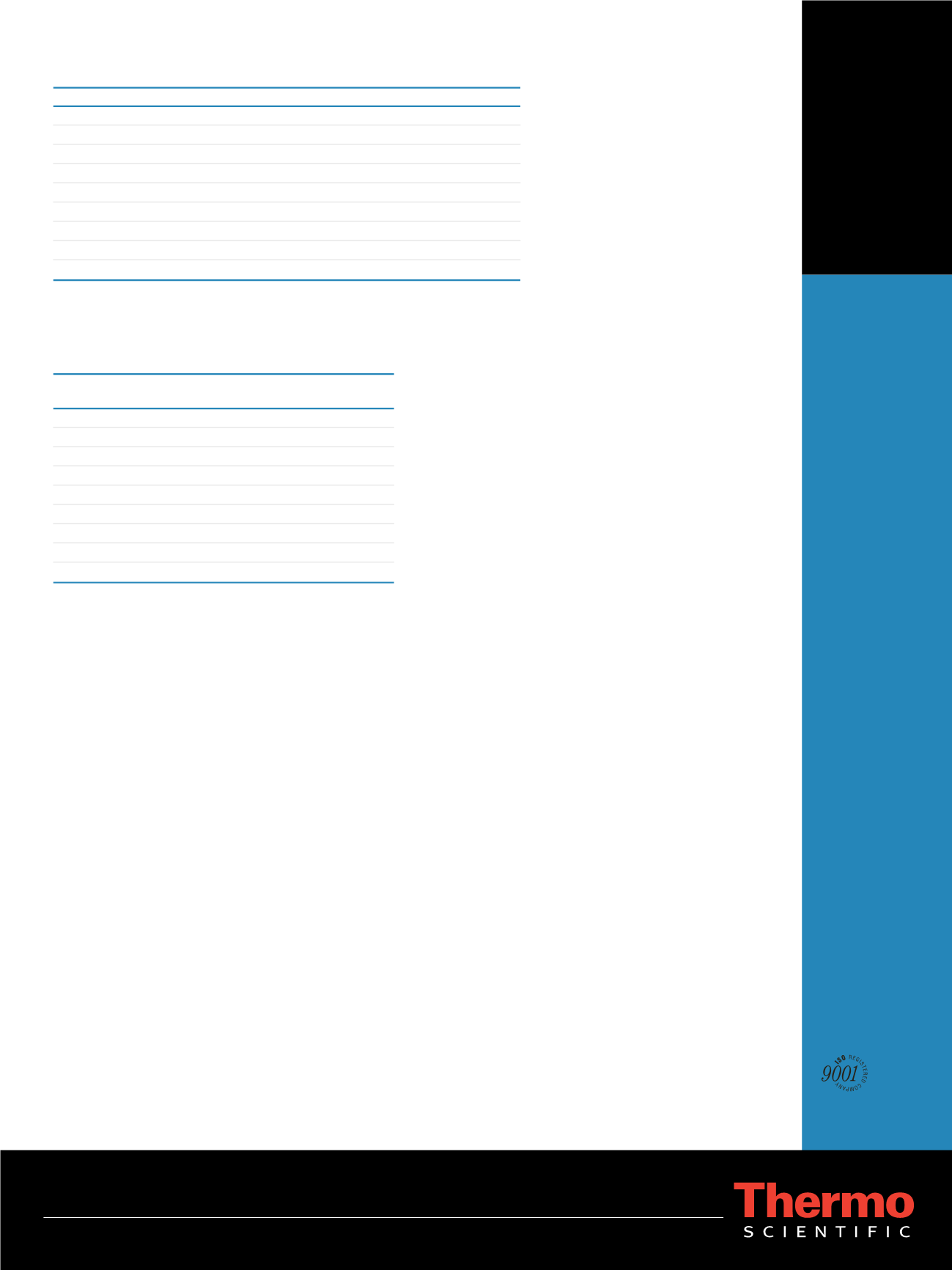

In addition to these
offices, Thermo Fisher
Scientific maintains
a network of represen-
tative organizations
throughout the world.
Africa-Other
+27 11 570 1840
Australia
+61 2 8844 9500
Austria
+43 1 333 50 34 0
Belgium
+32 2 482 30 30
Canada
+1 800 530 8447
China
+86 10 8419 3588
Denmark
+45 70 23 62 60
Europe-Other
+43 1 333 50 34 0
Finland/Norway/
Sweden
+46 8 556 468 00
France
+33 1 60 92 48 00
Germany
+49 6103 408 1014
India
+91 22 6742 9434
Italy
+39 02 950 591
Japan
+81 45 453 9100
Latin America
+1 608 276 5659
Middle East
+43 1 333 50 34 0
Netherlands
+31 76 579 55 55
South Africa
+27 11 570 1840
Spain
+34 914 845 965
Switzerland
+41 61 716 77 00
UK
+44 1442 233555
USA
+1 800 532 4752
www.thermo.comAN62963_E 01/09S
Part of Thermo Fisher Scientific
Thermo Fisher Scientific,
San Jose, CA USA is ISO Certified.
Legal Notices
©2009 Thermo Fisher Scientific Inc. All rights reserved. IonPac, ASRS, and Dionex are registered trademarks of Dionex Corporation. All other trademarks
are the property of Thermo Fisher Scientific Inc. and its subsidiaries. This information is presented as an example of the capabilities of Thermo Fisher
Scientific Inc. products. It is not intended to encourage use of these products in any manners that might infringe the intellectual property rights of others.
Specifications, terms and pricing are subject to change. Not all products are available in all countries. Please consult your local sales representative for
details.
View additional Thermo Scientific LC/MS application notes at:
www.thermo.com/appnotesConclusion
IC-MS/MS is a powerful tool used in the quantitation of
haloacetic acid samples. When compared to the
conventional EPA methods using GC with electron
capture, using IC-MS/MS to analyze for haloacetic acids
saves analysts several hours of sample preparation
because there is no requirement for sample pre-
treatment. The resolution between the matrix peaks and
haloacetic acids is excellent, which allows for minimum
interference in detection.
Excellent recoveries and reproducibility were
achieved when samples were spiked into a simulated
matrix containing 250 mg/L of each of chloride and
sulfate, 150 mg/L bicarbonate, 30 mg/L of nitrate and
100 mg/L ammonium chloride preservative for a total
chloride concentration of 316 mg/L. Results are
comparable to those achieved in EPA Method 552.2.
Analyte
Average RT
%RSD RT Average Area %RSD Area
MCAA
12.59
0.00
764439
2.34
MBAA
14.06
0.27
1627886
2.91
DCAA
24.44
0.02
11236488
3.98
BCAA
26.88
0.18
2468467
4.85
DBAA
30.09
0.16
731710
3.26
TCAA
39.05
0.24
4855405
10.98
BDCAA
45.13
0.04
1212887
4.78
DBCAA
43.55
0.07
1064
22.20
TBAA
47.44
0.25
1333
17.60
Calculated EPA Method
Analyte
MDL (µL/L)
552.2 MDL (µL/L)
MCAA
0.203
0.273
MBAA
0.392
0.204
DCAA
0.097
0.242
BCAA
0.136
0.251
DBAA
0.100
0.066
TCAA
0.403
0.079
BDCAA
0.159
0.091
DBCAA
0.459
0.468
TBAA
0.407
0.820
References
1. U.S. Environmental Protection Agency,
Microbial Health Effects Tables:
Potential Adverse Health Effects from High/Long-term Exposure to
Hazardous Chemicals in Drinking Water,
2002.
2. U.S. Environmental Protection Agency, Method 552.1,
Determination of
Haloacetic Acids and Dalapon in Drinking Water by Ion Exchange
Liquid-Solid Extraction and Gas Chromatography with Electron
Capture Detection,
Rev. 1.0, 1992.
3. U.S. Environmental Protection Agency, Method 552.2,
Determination of
Haloacetic Acids and Dalapon in Drinking Water by Liquid-Liquid
Extraction, Derivatization, and Gas Chromatography with Electron
Capture Detection,
Rev 1.0, 1995.
4. U.S. Environmental Protection Agency, Method 552.3,
Determination of
Haloacetic Acids and Dalapon in Drinking Water Liquid-Liquid
Microextraction, Derivatization, and Gas Chromatography with
Electron Capture Detection,
Rev 1.0, 2003.
5. Slignsby, R.; Saini, C.; Pohl, C.; Jack, R.
The Measurement of Haloacetic
Acids in Drinking Water Using IC-MS/MS–Method Performance,
Presented at the Pittsburgh Conference, New Orleans, LA, March 2008.
Table 5. Reproducibility of area and retention time in the TSQ Quantum Access for seven injections
of 2 ppb concentration in simulated matrix
Table 6. Calculated MDL response of HAA9 on the TSQ Quantum Access



















